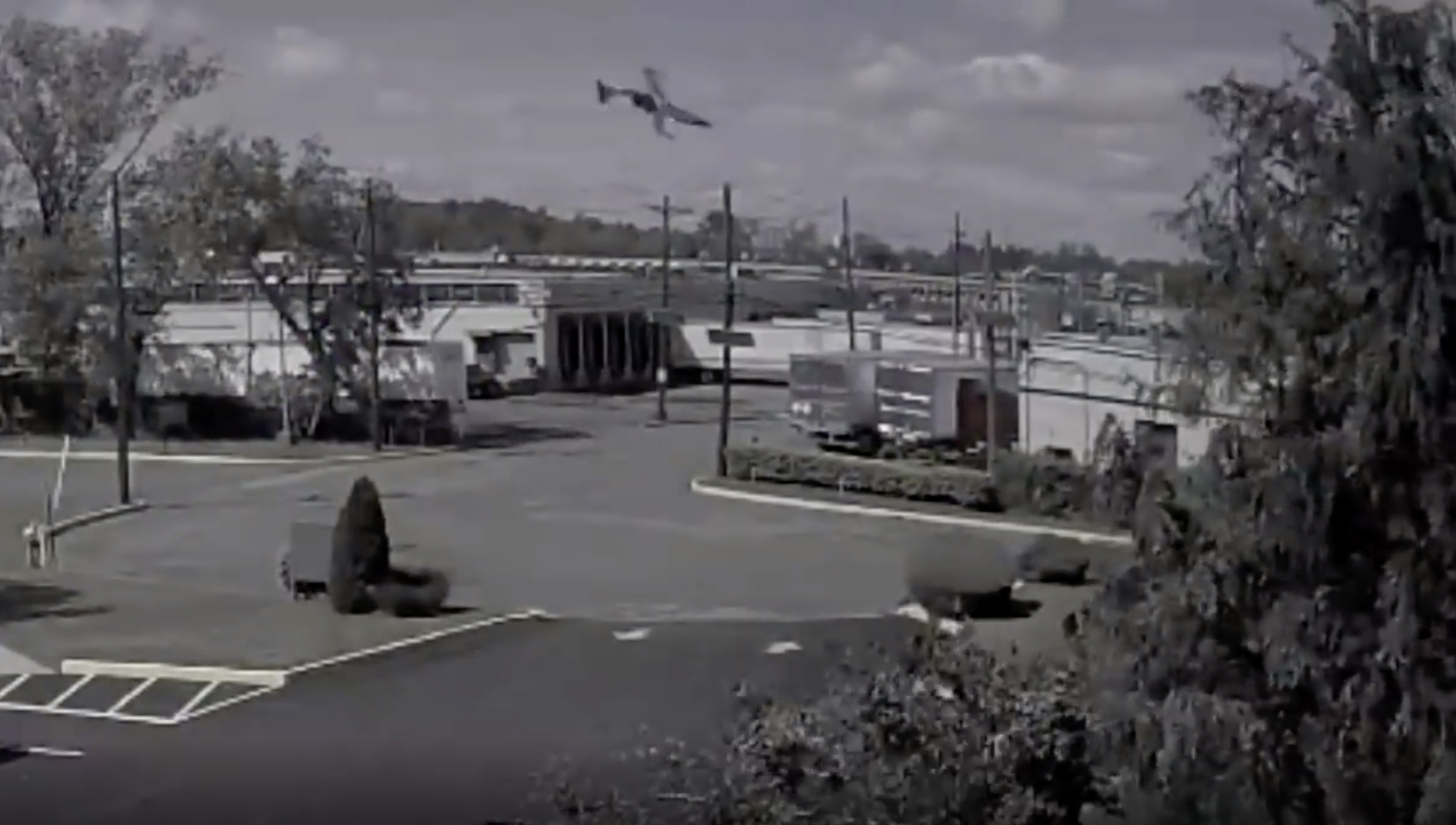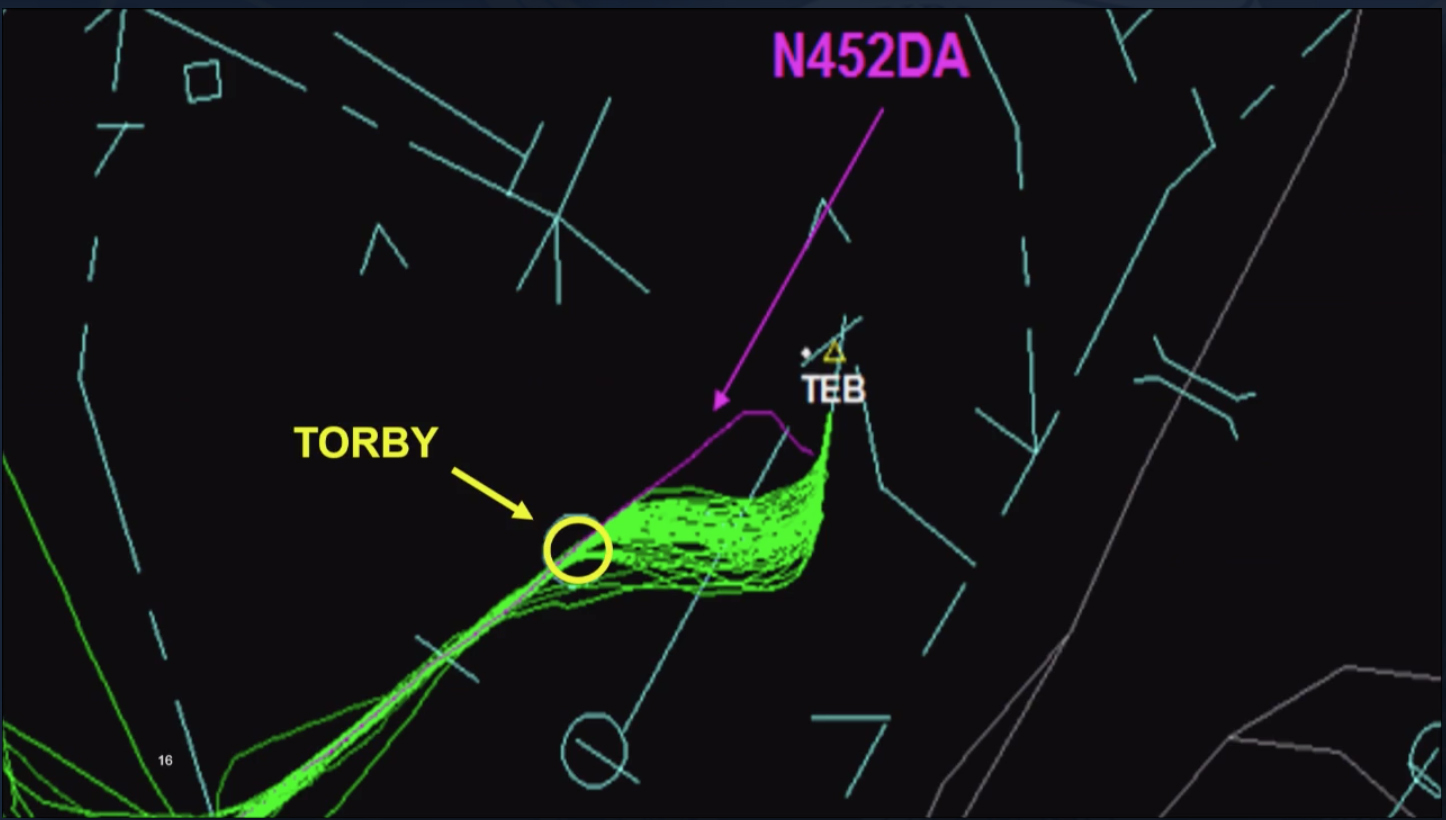As an Air Force Safety Officer, I was taught my prime purpose in life was to prevent recurrence. We investigated accidents, figured out what happened, and made recommendations to ensure it never happened again. The NTSB usually does a good job of this. But in this case, they did not.
— James Albright

Updated:
2019-04-09
As for what happened: NTSB Animation
If you read the NTSB Final Report, you come away mostly with deficiencies in the operator's 135 program, which were indeed deficient. You come away with the deficiencies in the pilots, and they were deficient. And you find out the operator didn't have wind additive guidance in their SOPs. That is all true. But they missed the cause, which was the pilots failed to understand the purpose of the circling maneuver and how to safely execute that maneuver..
If an accident report gets the cause wrong, you can usually figure it out with the list of recommendations. Not so with this report, which lists two about 14 CFR 135 programs and guidance, and one about speed additives. The NTSB missed an opportunity to fix what is wrong with how many pilots look at the circling maneuver. I'll venture my opinion below, in the Postscript.
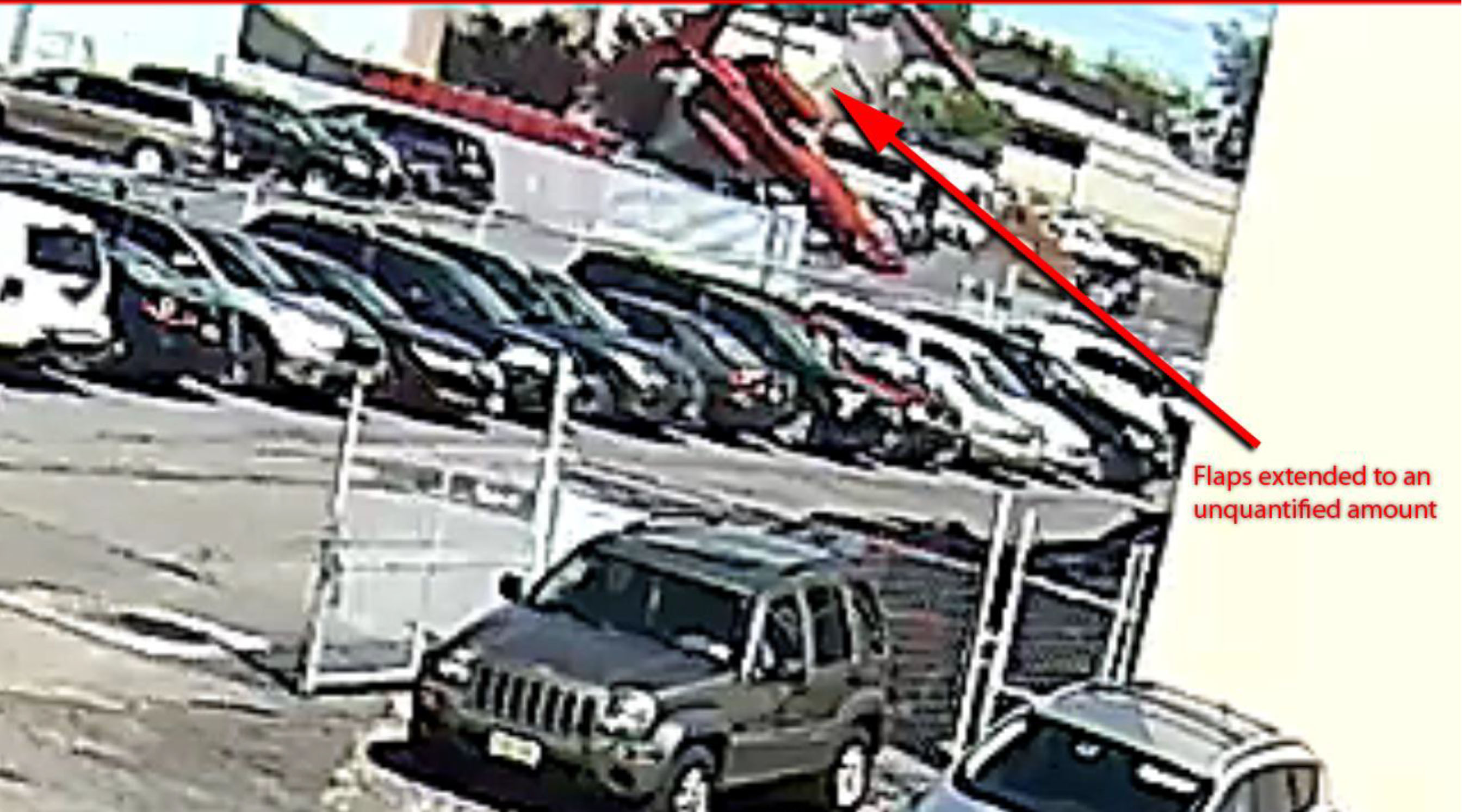
Security video shot at 770 Commercial Avenue, Accident Docket, Security Video Recordings, Figure 4.

1
Accident report
- Date: 15 May 2017
- Time: 1452 EDT
- Type: Gates Learjet 35A
- Operator: Trans-Pacific Jets
- Registration: N452DA
- Fatalities: 2 of 2 crew, 0 of 0 passengers
- Aircraft fate: Destroyed
- Phase: Approach
- Airport (departure): Philadelphia, PA (KPHL), USA
- Airport (arrival): Teterboro, NJ (KTEB), USA
2
Narrative
- On May 15, 2017, at 1529 eastern daylight time, a Gates Learjet 35A, N452DA, operated by Trans-Pacific Jets, departed controlled flight while on a circling approach to runway 1 at the Teterboro Airport (TEB), Teterboro, New Jersey, and impacted a commercial building and parking lot. The captain and first officer died; no one on the ground was injured. The airplane was destroyed by impact forces and postcrash fire. The airplane was registered to A&C Big Sky Aviation LLC and operated by Trans-Pacific Air Charter LLC under the provisions of 14 Code of Federal Regulations Part 91 as a positioning flight. Visual meteorological conditions prevailed, and an instrument flight rules (IFR) flight plan was filed. The flight departed from the Philadelphia International Airport (PHL), Philadelphia, Pennsylvania, about 1504 and was destined for TEB.
- The accident flight was the crewmembers' third flight of the day. The first flight departed TEB about 0732 on a Part 91 positioning flight and landed about 0815 at the Laurence G. Hanscom Field (BED), Bedford, Massachusetts, where they refueled and boarded a passenger. They departed BED about 1009 on a Part 135 on-demand charter flight and landed at PHL about 1104.
- The captain filed an IFR flight plan to TEB planning a 28-minute flight at a cruising altitude of flight level 270 (27,000 feet) with a cruise speed of 441 knots and a departure time of 1430. After departure about 1504, the flight was cleared to climb to 4,000 feet above mean sea level (msl). The flight reached a maximum altitude of 4,000 feet msl. About 1515, the flight was cleared to descend to 3,000 ft msl. The New York Terminal Radar Approach Control (TRACON) cleared the flight for the TEB ILS Runway 6 Approach, circle to land runway 1. TRACON instructed the flight to switch frequencies and contact TEB air traffic control (ATC) about 9 miles from the airport; however, the flight did not check onto the ATC's frequency until 4 miles from the airport. ATC cleared the flight to land on runway 1 and issued the TEB winds of 320 degrees at 16 knots, gusting to 32 knots.
- Radar track data indicated that the flight did not start its right circling turn until it was less than 1 mile from the approach end of runway 6. According to TEB ATC, aircraft typically start the right turn at the final approach fix for runway 6, which is located 3.8 nm from the approach end of runway 6.
- A TEB ATC controller reported that he observed the airplane bank hard to the right and he could see the belly of the airplane with the wings almost perpendicular to the ground. The airplane then appeared to level out for just a second or two before the left wing dropped, showing the entire top of the airplane. Other ground witnesses also reported that they observed the airplane in a right turn with the wings in a high angle of bank. Some witnesses described seeing the airplane's wings "wobbling" before the left wing dropped and the airplane descended to the ground. Security video cameras installed at numerous commercial buildings also captured the last moments of the flight, showing the airplane at high angles of bank. One security camera showed the airplane in a steep right wing low, nose down attitude at impact.
- The accident site was located on a 180-degree bearing about 1/2 nautical miles from the threshold of runway 1 at TEB. The main wreckage was distributed in the parking lots of commercial businesses. The wreckage path and debris field was about 440 ft. long on a 135-degree heading, and 3 buildings and 16 vehicles were damaged by impact or fire. Although impact forces and postcrash fire destroyed and consumed much of the airplane, the examination of the wreckage revealed that all components of the airplane were located at the accident site.
Source: Accident Docket, Preliminary Report
3
Analysis
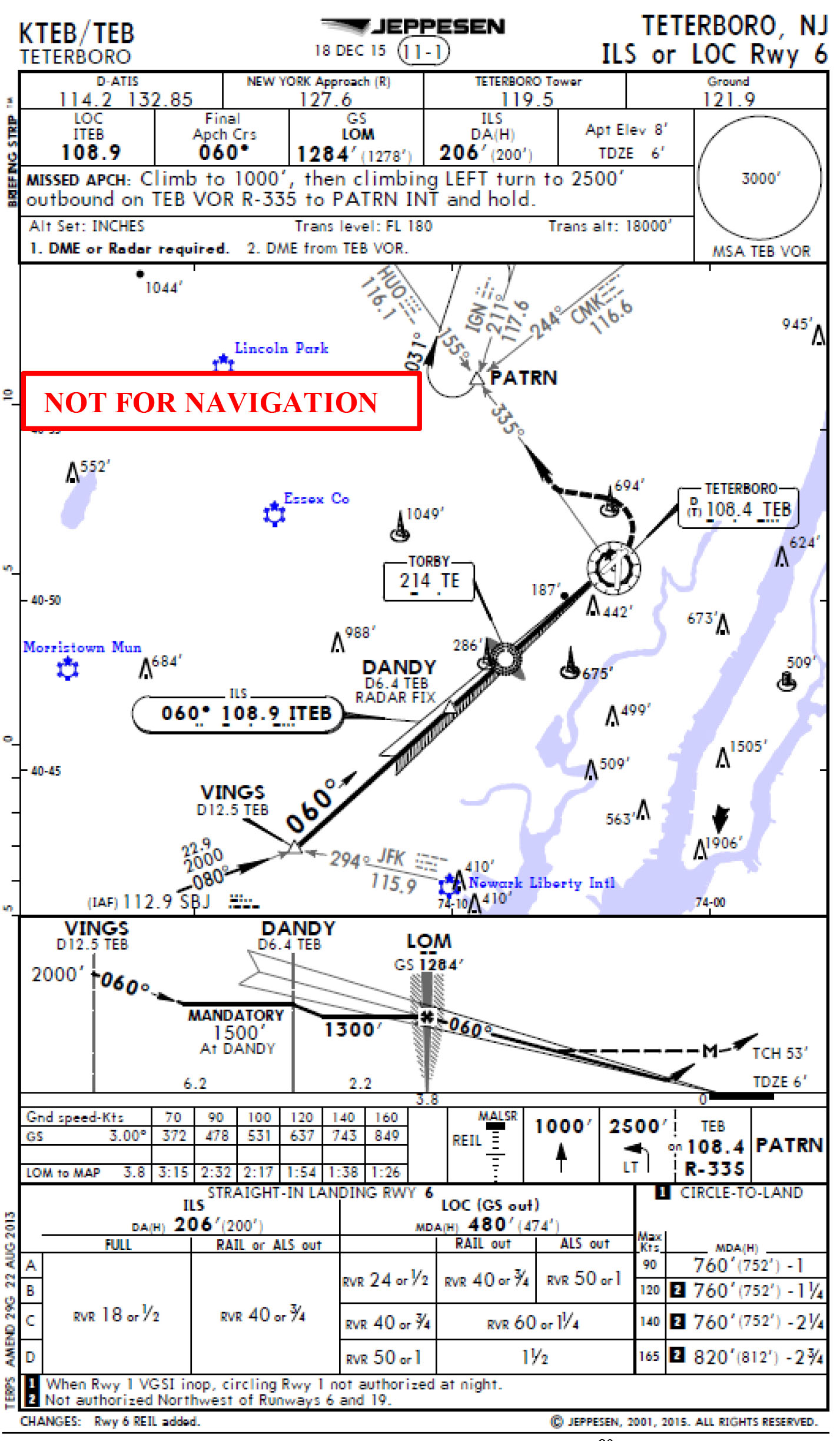
Teterboro ILS 06, from NTSB Accident Docket, Operational Factors, Figure 4.
ATIS
It appears the captain handed the ATC frequency to the first officer while attempting to get ATIS, but he only got fragments of it. His attention was also devoted to closely monitoring the first officer who deviated from the assigned altitude at least once.
- 15:15:25.0 HOT-1 — I gotta’ get the # ATIS. #. I didn't realize we're that # close.
- 15:15:46.9 ATIS-TEB — departure. ** (fly the procedure as published). all pilots follow noise abatement procedures. read back hold short instructions ** — [static throughout transmission]
- 15:16:12.8 ATIS-TEB — [static] visibility [static].
- 15:16:16.0 ATIS-TEB — light rain. five thousand five hundred scattered. temperature one eight. dew point six. altimeter two niner seven four [static throughout transmission].
- 15:16:26.9 ATIS-TEB —* approach in use ***. V-F-R departures contact clearance delivery on one two eight point zero five prior to taxi. bird activity in the vicinity of Teterboro airport. *** — [static throughout transmission]
- 15:16:44.8 ATIS-TEB — (departure.) comply with altitude restrictions as published— [static throughout transmission]
Source: Accident Docket, Group Chairman's Factual Report
Approach Clearance
The aircraft's base turn is less than 1 nautical mile from the runway. Note the position of the stadium. A normal base turn for the ILS 6 circle to Runway 01 would be outside of that stadium. Note the EGPWS times do not correlate with actual time.
In the moments leading up to when New York Approach issued the aircraft's approach clearance, the captain was busy running the checklist, talking on the radio, programming the FMS, and teaching the first officer basic flight operations, such as speed control. The first officer was chasing airspeed with thrust and asking questions like "should I trim more?"
- 15:23:23.7 APP-NYC — Learjet four five two delta alpha is eight miles from VINGS cross VINGS at two thousand feet, cleared I-L-S runway six. circle runway one.
- 15:23:31.1 RDO-1 — okay cleared I-L-S six circle one uh VINGS two thousand. four five two delta alpha.
- 15:23:40.5 APP-NYC — two four zero knots till VINGS and then uh you can slow to one eight zero knots maintain that till TORBY.
- 15:23:45.3 RDO-1 — alright. two forty until VINGS eh two thousand on the altitude and we can slow it down to one eighty to TORBY. four five two delta alpha.
Source: Accident Docket, Group Chairman's Factual Report
"Circle"
The pilots hear "circle runway one" and appear to believe that means descend to the MDA and, perhaps, the circling approach radii.
- 15:24:04.2 HOT-1 — six miles to VINGS. maintain two forty till VINGS two thousand on the altitude. we're circling runway one.
- 15:24:11.1 HOT-1 — so circling minimums.
- 15:24:13.3 HOT-1 — is seven hundred and sixty.
- 15:24:15.6 HOT-2 —oh #.
- 15:24:16.6 HOT-1 — yeah.
Source: Accident Docket, Group Chairman's Factual Report
- About 1526 EDT, N452DA was told to contact TEB tower and to cross DANDY16 at 1,500 ft msl and circle at TORBY. N452DA responded with “alright DANDY at two hundred feet circle at Torby,” which was corrected by the controller to cross DANDY at 1,500 ft, and then acknowledged by N452DA. Around the same time, another airplane on the circle approach elected to go around, telling the TEB tower that “the winds weren't favorable at that time.” TEB tower did not initially hear from N452DA after they were told to switch frequencies, and the tower made two attempts to contact N452DA when the Newark controller had to remind N452DA to contact the tower a second time. About 1528 EDT, N452DA contacted the TEB tower while the airplane was 2.65 nautical miles (NM) southwest of the airport. The co-pilot of a Challenger 300 on the circle approach that landed ahead of N452DA stated that there was some turbulence on the approach, and the tailwinds were manageable from where they started their initial circling turn at TORBY.
- About 1528 EDT, TEB tower told N452DA the wind conditions as 360 at 16 knots, gusts to 32, and to continue towards runway 01 as another airplane was occupying runway one and awaiting departure, and N452DA acknowledged with their call sign. About a minute later, after clearing the other airplane on the runway for takeoff, TEB tower cleared N452DA to land on runway 01.
Source: Accident Docket, Operational Factors / Human Performance
The captain was very busy watching the first officer who attempted to descend prior to glide slope intercept and was still having airspeed control issues. Once they intercepted the glide slope and were handed off to tower, they began their descent to the MDA.
- 15:28:27.1 HOT-1 — seven sixty. [emphasized]
- 15:28:29.7 HOT-2 — seven sixty roger.
- 15:28:58.2 HOT-1 — 'kay we're gonna circle for runway one.
- 15:29:00.1 HOT-2 — okay.
- 15:29:00.7 HOT-1 — so we're kinda on a downwind.
- 15:29:03.7 HOT-1 — so. go'head.
- 15:29:04.3 HOT-? — [sound of unintelligible whisper]
- 15:29:05.1 HOT-1 — break off the autopilot.
- 15:29:06.1 CAM — [sound similar to autopilot disconnect tone]
- 15:29:06.8 HOT-2 — there ya go.
- 15:29:07.1 HOT-1 — hand on the #—
They descended to 800 feet.
Source: Accident Docket, Group Chairman's Factual Report

Radar plot depicts the location of N452DA when the TEB local controller asked if the pilot was going to start the turn, from NTSB Accident Docket, ATC Attachment 2, Figure 6.
The aircraft was 1.54 NM from Runway 01 when the controller asked if they were going to start the turn. The captain dropped a hint about 7 seconds earlier (about a tenth of a nautical mile). Category D circling radii under the classic "old school" TERPS criteria was 2.3 nm. (See Circle Approach Area for more about this.)
- 15:29:07.3 TWR-TEB — (delta alpha) you gonna start that turn?
- 15:29:09.2 RDO-1 — yeah sir we're doin’ it right now four (sixty) delta alpha.
- 15:29:12.1 HOT-1 right.
- 15:29:12.6 CAM — [sound similar to decrease in drag noise]
- 15:29:13.8 HOT-1 — [sound similar to sigh]
- 15:29:14.7 HOT-1 — watch the airspeed.
- 15:29:15.3 HOT-2 — your flight controls. [emphasized]
- 15:29:16.7 CAM — [sound of faint mechanical whine]
- 15:29:17.6 CAM — [sound of high pitch tone, similar to altitude alerter]
- 15:29:18.0 HOT-1 — there we go.
- 15:29:18.8 EGPWS — five hundred.
- 15:29:19.8 HOT-1 — disregard.
- 15:29:21.1 HOT-2 — roger. [strained voice]
- 15:29:21.6 EGPWS — sink rate. pull up.
Source: Accident Docket, Group Chairman's Factual Report
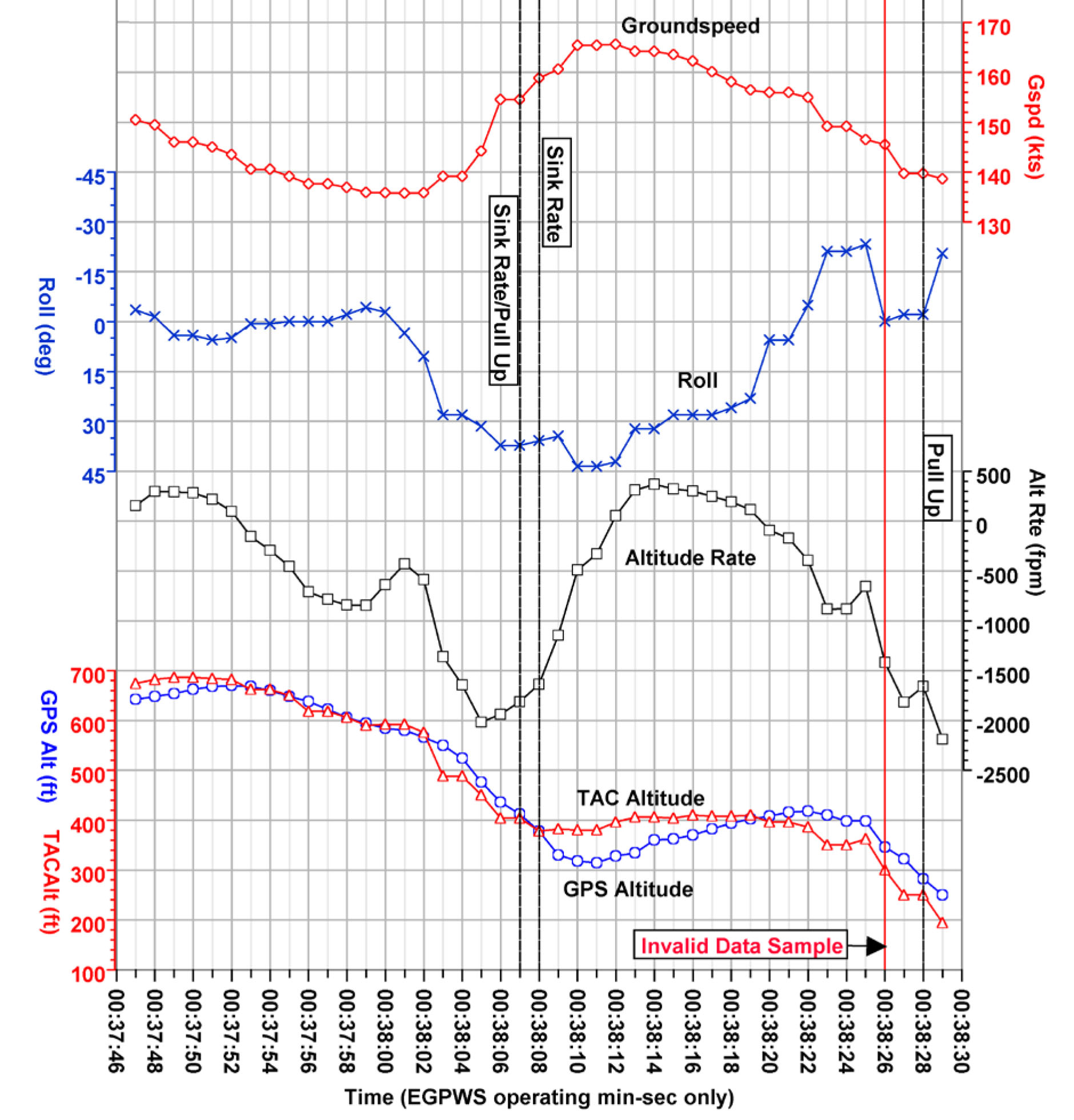
EGPWS record of roll, altitude rate, and altitude, from NTSB Accident Docket, EGPWS, Figure 2.
The EGPWS non-volatile memory1 (NVM) does not continuously record; rather, the EGPWS device stores data to NVM only when certain criteria are met. The readout process at the manufacturer’s facility produces several files of flight history data that encompass operational, documentary, fault, and warning information.
Source: Accident Docket, EGPWS, ¶2.1
The timing on the EGPWS graph does not correlate to actual flight time, GMT, or local EDT. It is simply a running record of EGPWS events. The target altitude was approximately 700 feet. The bank angle was recorded no higher than 45° though eye witnesses had it much higher. The ground speed shown includes a tailwind of about 30 knots.
- 15:29:26.2 HOT-2 — meeeh. [strained voice] I'm gonna give ya your controls okay?
- 15:29:28.5 HOT-1 — alright. my controls.
- 15:29:29.2 HOT-2 — your flight controls.
- 15:29:30.3 HOT-1 — # eh. [spoken in angry tone]
- 15:29:31.5 HOT-1 — watch my airspeed.
- 15:29:32.7 HOT-2 — yup.
- 15:29:32.8 CAM — [sound similar to high frequency aerodynamic noise]
- 15:29:33.6 HOT-1 — [heavy breathing]
- 15:29:34.5 HOT-2 — lookin' good.
- 15:29:35.5 HOT-2 — V-ref.
- 15:29:35.6 TWR-TEB — * contact departure one one niner point two.
- 15:29:35.6 HOT-1 — no.
- 15:29:38.1 HOT-2 — add airspeed. [emphasized] airspeed. airspeed. airspeed. [exclaimed]
- 15:29:40.6 HOT-1 — stall. [strained voice]
- 15:29:41.2 HOT-2 — yup.
- 15:29:41.6 CAM — [sound similar to high frequency aerodynamic noise]
- 15:29:42.3 HOT-1 — [sound of strained breathing]
- 15:29:43.1 HOT-2 — airspeed. airspeed. [exclaimed]
- 15:29:43.2 HOT-1 — #.
- 15:29:43.7 EGPWS — sink rate. pull up.
- END OF TRANSCRIPT — END OF RECORDING 15:29:44 EST
Source: Accident Docket, Group Chairman's Factual Report
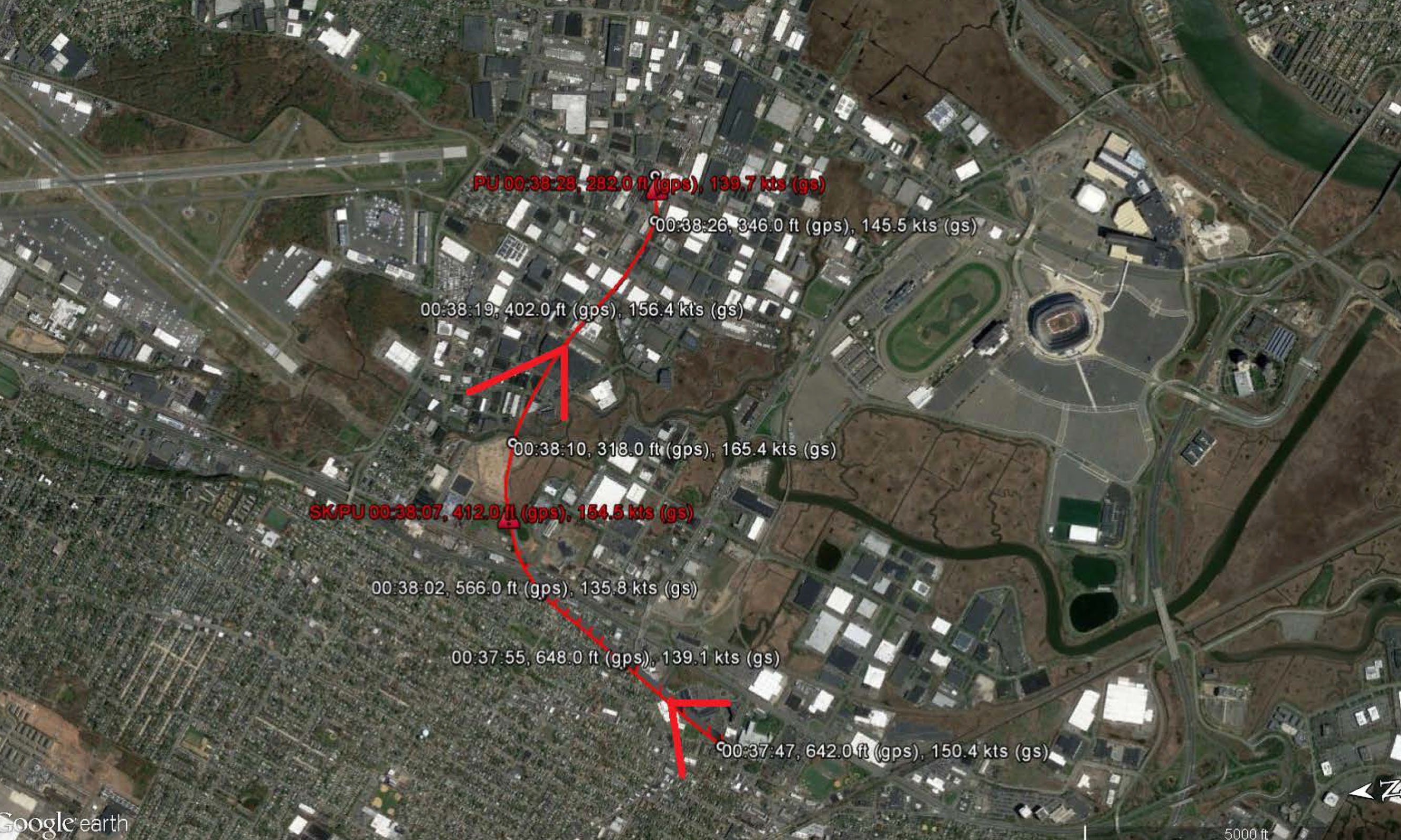
Satellite overlay, from NTSB Accident Docket, EGPWS, Figure 3.
The aircraft's base turn is less than 1 nautical mile from the runway. Note the position of the stadium. A normal base turn for the ILS 6 circle to Runway 01 would be outside of that stadium. Note the EGPWS times do not correlate with actual time.
Wind Additives
- Section II of the Lear 35A AFM stated the following Note: It is recommended that if turbulence is anticipated due to gusty winds, wake turbulence, or wind shear, the approach speed be increased. For gusty wind conditions, an increase in approach speed of one half the gust factor is recommended.
- There was no reference in the Trans-Pacific GOM or SOP manuals as to the amount of approach speed increase pilots should use when flying an approach in gusty wind conditions. The CAE Lear 35/36 Operating Handbook also did not reference any approach speed additives in gusty conditions.
- According to interviews, one CAE Simuflite Lear 35A instructor, when asked if there were any wind additives on the approach in the Lear 35A, said they would fly VREF plus the steady state wind plus ½ the gust factor. Another CAE Simuflite Lear 35A instructor, when asked the same question, said he would add 5 knots “or so” to the approach speed if it was windy, but there was no specific amount of additive for winds on the Lear 35A.
Source: Accident Docket, Operational Factors and Human Performance, ¶13.7.1
The Captain's Training
- The Captain attended Lear 35A training for Sunquest between July 17, 2016 and July 24, 2016. According to CAE Simuflite records and instructor interviews, the Captain was scheduled for one day of ground school on July 15, 2016, followed by one simulator training session and then a check ride per 14 CFR 135.293 (oral and competency recurrent) combined with a 14 CFR 135.297 check (instrument competency).
- According to CAE Simuflite records, the Captain required three additional simulator training sessions prior to his check ride. He accumulated a total of 17.5 hours of simulator time, which included 9.2 hours as pilot flying (PF) and 8.3 hours as pilot monitoring (PM). He conducted 8 ILS approaches, 9 non-precision approaches, 2 visual approaches, and 5 circle-to-land approaches. During the circle-to-land training conducted on July 17, 2016, he was graded “Not Yet Proficient – Additional Training Required,” and on July 18, 2016, he required additional training to meet proficiency requirements on circle-to-land approaches. According to a July 18, 2016 email from the Captain’s instructor, the Captain was not recommended for the check ride in the Lear 35, and he would need more training before being signed off. The instructor further requested the company [Trans-Pacific] be notified of the captain’s delayed check ride. On July 20, 2016, Trans-Pacific was notified of the additional training required for the Captain.
- According to the Chief Pilot, Trans-Pacific was aware of the captain’s training difficulties that included circling approaches and maintaining assigned altitudes, but attributed the difficulties to the Captain having flown a different airplane prior to flying the Lear 35A. According to internal CAE Simuflite emails, on July 17, 2016 the Captain’s instructor sent an email to the CAE Simuflite Lear manager, informing him that the Captain had been out of the airplane for 7 years and the instructor could not recommend the Captain for a check ride due to a lack of proficiency.
- The Captain satisfactorily completed proficiency checks on July 24, 2016, March 20, 2017 and a line check on October 7, 2016 that included circle-to-land approaches in the Lear 35A.
Source: Accident Docket, Group Chairman's Factual Report
The Second-in-Command's Training
- The SIC received his initial Lear training through the MedFlight Air Ambulance Air Carrier Training Program. On August 7, 2015, the SIC satisfactorily completed a 135.293(a) and (b) proficiency simulator check in the Lear 35A.
- The SIC attended Lear 35A training for Sunquest between September 16, 2016 and September 29, 2016. According to CAE Simuflite records and instructor interviews, the SIC was scheduled for a Part 135 5-day recurrent training curriculum (R5), which included two days of Lear 35A ground school, two days of simulator training, and one day for a check ride. The ground school began on September 16, 2016, and the simulator training began on September 18, 2016.
- According to CAE Simuflite simulator training records, the SIC required four additional simulator training sessions (for a total of 6 simulator training sessions) prior to conducting his check ride on September 29, 2016. He accumulated a total of 24.7 hours of simulator time, which included 18.6 hours as pilot flying (PF) and 6.1 hours as pilot monitoring (PM). He conducted 17 instrument approaches, 12 non-precision approaches, 2 visual approaches, and 5 circle-to-land approaches.48 During the circle-to-land training conducted on September 22, 2016 and September 25, 2016 he was graded “Not Yet Proficient – Additional Training Required.” On September 28, 2016 (the day before his proficiency check) he was graded proficient in circle-land approaches. His proficiency check on September 29, 2016 did not include a circle-to-land approach.
- According to the SIC’s instructor’s notes following the September 18, 2016 simulator training session, the SIC had the following training difficulties:
- Struggled with normal procedures
- Did not perform takeoff checks correctly or know what to look for during the checks
- Did not know how to start the engines
- Crashed on first takeoff due to incorrect flight director settings
- Unable to control speed and altitude during the stall series
- Flew inverted on the unusual attitude module
- Crashed on landing during an ILS approach
- According to internal CAE Simuflite emails, the instructor for the SIC informed the CAE Simuflite Lear manager that the SIC was not ready for his originally scheduled check ride, and the manager requested the SIC be removed from the scheduled check ride.
- CAE Simuflite notified the Director of Operations of Trans-Pacific that the SIC was not progressing through the training, and planned to continue working with the SIC. The SIC indicated that he was having a personality conflict with his instructor, and the SIC also requested additional ground school training and extra simulator time, which was approved by Trans-Pacific. According to the instructor, the SIC told him that he previously did not get much time at the Lear controls, and the instructor stated the SIC was behind in training.
Source: Accident Docket, Group Chairman's Factual Report
The FAA and the NTSB and Circling
I did a lot of circling as an Air Force pilot and with that I did a lot of training as a student and teaching as an instructor pilot. Our view of circling was a bit different than what you will find with many civilian pilots. In a nutshell: You circle at minimums (MDA and radii) only if you have to. If the weather permits, you circle as high as you can (up to traffic pattern altitude) and as wide as you can (up to a normal traffic pattern downwind), so as to make the visual picture as normal as possible.
Can you do this as a civilian pilot? Yes, there is nothing, absolutely nothing, that precludes you from taking this, the safer technique. If you spend a day watching the traffic pattern at Teterboro when the winds require circling to Runway 01 or Runway 24, you will quickly come to the conclusion that most civilian pilots understand this. Most, but not all.
We can only guess which camp these two Lear pilots fell into, but there is evidence they both had difficulties circling in training, both expressed fear at hearing Teterboro was using a circling approach, and that they didn't consider initiating their maneuvering much earlier than they did. Initiating the turn to base at the instrument circling radii with an overshooting wind is virtually impossible.
So who is to blame for the mindset that you must circle at the MDA and within the circling radii? Let's look at how the NTSB and FAA treat it with this accident investigation.
Due to the winds at TEB on May 15, 2017, ATC issued the accident flight a clearance to execute an ILS 06 instrument approach, circle-to-land approach to runway 01. There was no published straight-in instrument approach to runway 01 at TEB.
Source: Accident Docket, Operational Factors and Human Performance, ¶10.1
- According to the Pilot/Controller Glossary published in the Aeronautical Information Manual (AIM), a circle-to-land was a maneuver initiated by the pilot to align the aircraft with a runway when a straight-in landing from an instrument approach was not possible or was not desirable. At tower controlled airports, this maneuver was made only after ATC authorization had been obtained and the pilot had established required visual reference to the airport.
- A “circle to runway” clearance was used by ATC to inform the pilot that h/she must circle to land because the runway in use was other than the runway aligned with the instrument approach procedure. The direction of the circling maneuver in relation to the airport/runway was required, the controller must state the direction and state the direction (eight cardinal compass points) and specify a left or right downwind or base leg as appropriate. According to the AIM (page 5-4-54), standard left turns or specific instruction from the controller for maneuvering must be considered when circling to land.
- Circling minimums were published on approach charts as a statement of the minimum descent altitude (MDA) required for the circling maneuver and the visibility requirements for the approach. Published circling minimums provided obstacle clearance when pilots remained within the appropriate area of protection. Pilots would determine the category of the airplane for the approach based on the approach speed of the airplane, which in turn would determine the MDA and visibility requirements for the circle-to-land approach as depicted on the approach chart. According to 14 CFR 97.3, an aircraft approach category means a grouping of aircraft based on a speed of VREF, if specified, or if VREF is not specified, 1.3 Vso at the maximum certificated landing weight. VREF, Vso, and the maximum certificated landing weight were those values as established for the aircraft by the certification authority of the country of registry. The categories were as follows:
- Category A: Speed less than 91 knots.
- Category B: Speed 91 knots or more but less than 121 knots.
- Category C: Speed 121 knots or more but less than 141 knots.
- Category D: Speed 141 knots or more but less than 166 knots.
- Category E: Speed 166 knots or more.
- The FAA Instrument Procedures Handbook (FAA-H-8083-16A), page 4-8 and 4-9, stated that the circling approach area was the obstacle clearance area for airplanes maneuvering to land on a runway that does not meet the criteria for a straight-in approach. A minimum of 300 feet of obstacle clearance was provided in the circling segment, and pilots should remain at or above the circling altitude depicted on the approach chart until the airplane was continuously in a position from which a descent to a landing on the intended runway could be made at a normal rate of descent and using normal maneuvers.
- The circling approach protected areas developed prior to 2012 used the radius distances shown in the following table, expressed in nautical miles, dependent on aircraft approach category:
- Cat A: 1.3 NM
- Cat B: 1.5 NM
- Cat C: 1.7 NM
- Cat D: 2.3 NM
- Cat E: 4.5 NM
- According to the FAA, beginning with the November 15, 2012 chart publication date, the FAA began publishing new circling criteria (TERPS 8260.3B Change 21) that affected the circling approach area dimensions by expanding the areas to provide better obstacle protection. The new circling approach areas used an expanded radius distance from the runway, and included a circling altitude which accounted for the true airspeed increase with altitude, dependent on aircraft category.
Source: Accident Docket, Operational Factors and Human Performance, ¶110.3 Circling Approach Protected Area.
- The affected approach procedures would be denoted on the approach chart with a negative “C” on the circling line of the minima table to which the new criteria had been applied.
- An example of an instrument approach chart minimums table with the expanded circling approach area dimensions was as follows:
Source: Accident Docket, Operational Factors and Human Performance, ¶110.3 Circling Approach Protected Area.
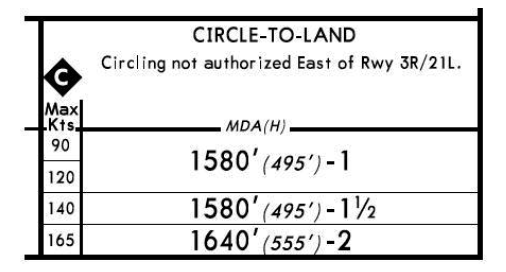
Accident Docket, Operational Factors and Human Performance, ¶110.3 Circling Approach Protected Area.
- The NTSB requested the FAA provide a pictorial chart showing the current circling approach protected areas surrounding TEB (see Attachment 21 – TEB Protected Airspace Charts).88 The first chart provided by the FAA showed the protected airspace around TEB with the pre-2012 criteria, and the second chart showed the protected airspace around TEB using the current Change 21 criteria. According to the FAA, the Change 21 circling areas had not yet been applied to all approaches, including those at TEB. The Jeppesen 11-1 ILS06 approach at TEB did not have the negative “C”, and TEB used the pre-2012 approach category and circling radius (See Figure 9) for circling approaches at TEB on the day of the accident.
- According to the FAA, when Change 21 is eventually applied to TEB approaches, the circling radii will result in no change to Category A aircraft, a 0.31 nautical mile increase to Category B, a 1.13 nautical mile increase to Category C, and a 1.4 mile increase to Category D.
- According to ATC transcripts, on the day of the accident, multiple airplanes (including the accident airplane) were cleared for the TEB ILS06 circle-to-land runway 01, and were told to begin their circling maneuver after the TORBY intersection. TORBY was the FAF for the ILS06 approach and located 3.8 nautical miles from the threshold of runway 06.
Source: Accident Docket, Operational Factors and Human Performance, ¶110.3 Circling Approach Protected Area.
The report goes on to explain the operator was authorized to conduct circling approaches, that they were taught to use Category D minimums in the Lear 35.
The report spends some time on the operator's classification of SICs who were not authorized to fly, on the Principal Operations Inspector's lack of hands on oversight, and various other problems with the operation. But nothing else on what actually happened in this accident: the pilots did not understand the circling maneuver and were poorly trained to circle in a real world situation. To illustrate this blind eye, you need only look at the "Past Recommendations" offered in paragraph 17. In this section, the investigators offered a look at four other accidents with what they thought to be similar causes. These included a case of inadequate tire inflation, an attempted go around after landing, a botched stall recovery, and a descent below minimums.
4
Cause
If I had written this probable cause statement when I was in Air Force Safety School, the instructor would have said, "The attempt to salvage an unstabilized visual approach is WHAT happened not WHY it happened. Try again." I will try again below, In My Opinion.
The NTSB determines that the probable cause of this accident was the PIC’s attempt to salvage an unstabilized visual approach, which resulted in an aerodynamic stall at low altitude. Contributing to the accident was the PIC’s decision to allow an unapproved SIC to act as PF, the PIC’s inadequate and incomplete preflight planning, and the flight crew’s lack of an approach briefing. Also contributing to the accident were Trans-Pacific’s lack of safety programs that would have enabled the company to identify and correct patterns of poor performance and procedural noncompliance and the FAA’s ineffective SAS procedures, which failed to identify these company oversight deficiencies.
Source: NTSB Final Report AAR-19/02
5
Postscript
In my opinion . . .
The reason we go through the trouble of thoroughly investigating these kinds of accidents is to figure out: (1) what went wrong, (2) why, and to figure out (3) how to prevent if from happening again. The NTSB report never got passed step 1.
A common mistake in accident investigators is to worry about the litigation sure to follow. They are reluctant to step out on a limb. When your job is to prevent recurrence, you are allowed to speculate and you shouldn't be worried about having a legal basis for everything you have to say. Let's do that here.
What went wrong
- Both pilots lacked the situational awareness to deal with the crowded airspace and frenetic pace often found at Teterboro.
- Both pilots appeared to fear the "circle to ___" instruction as evidenced by the PIC's reluctance to take the airplane when asked to and the SICs reluctance to begin the maneuver.
- Both pilots seemed to believe the circling maneuver had to be completed close to the airport, within the radii specified in their instrument manuals, and no higher than the published MDA.
- By the time they began the circle, it was too late to safely maneuver to the landing runway.
- The pilots didn't understand that a go around was an acceptable "Plan B."
Why
- The tower operators at Teterboro are among the world's best and on a calm wind day with lower than normal traffic loads, things can lull pilots into thinking "what the big deal? This is easy." But if these same pilots had never seen Teterboro on a busy day with bad weather or unfavorable winds, they can be surprised.
- Under most simulator-based training programs, pilots are required to demonstrate a circle-to-land maneuver off an instrument approach to minimums, where flying beyond the circling radii or well above the MDA is considered a "fail."
- Most training manuals and the AIM do not include acceptable techniques for when the weather permits higher altitudes and larger radii.
- Training programs emphasize the need to land from the maneuver and a go around is often considered a failed maneuver.
How to prevent it from happening again
- Address the various training manuals and AIM to include the concepts of circling as high as traffic pattern altitude if the ceiling permits, and as wide as a normal traffic pattern radii unless otherwise instructed.
- Adapt training programs to no longer require demonstration at minimums but include variable conditions which require pilots to demonstrate an understanding of just how high and wide they can fly while maneuvering.
- Disallow the practice of requiring circle-to-land maneuvers in training at minimums that can only be completed by an unstable final approach. In other words, if the simulated weather requires a rollout below 500 feet, it is negative training. Simulator instructors often tolerate high bank angle maneuvering because their scenarios made such maneuvers necessary. If the turn to final can't be made with less than 25 or 30 degrees of bank, chances are the weather is too low.
- The Teterboro User's Group has tried unsuccessfully to develop a Charted Visual Flight Procedure for Runway 1 but have been stymied because of FAA rules that prohibit the procedure be loadable from a navigation database, have crossing restrictions, or include missed approach procedures. I know there are problems fitting a procedure into the airspace with Newark and La Guardia right next door. It seems to me that something like the Sound Visual Rwy 34 at White Plains or the Quiet Bridge Visual Runway 28L/R at San Francisco would go a long way to ensuring pilots maintain a safer ground track into Runway 1 at Teterboro. If the problem is FAA rules, then someone at the FAA needs to realize they are failing in their published mission statement: to provide the safest, most efficient aerospace system in the world.
- The New York City Area approach controllers and the tower controllers at Teterboro are top notch. On a calm wind day with moderate to light air traffic, flying into Teterboro can seem very easy. But if you've never flown into Teterboro on a gusty wind day or one with heavy air traffic, you can be surprised. I recommend the airport expand on their very good Flight Crew Briefing (link below) and add Circle to Runway 1 and Circle to Runway 24 procedures. They should also consider requiring pilots complete this course prior to operating at Teterboro.
References
(Source material)
Accident Docket, Lear 35 N452DA, NTSB CEN17MA183
Departure From Controlled Flight, Trans-Pacific Air Charter, LLC, Learjet 35A, N452DA, Teterboro, New Jersey, May 15, 2017, Final Report NTSB/AAR-19/02, Public Meeting March 12, 2019
